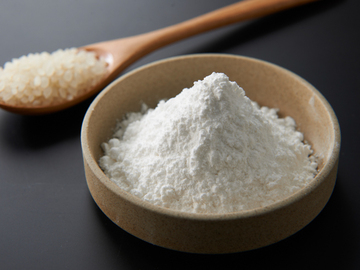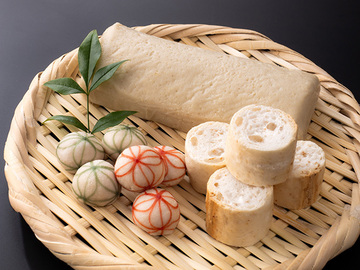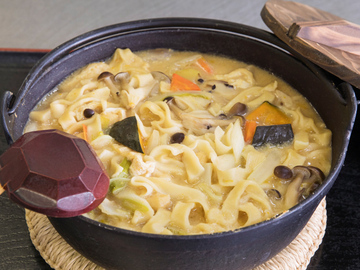Grain products

History and Culture
Cereals refer to rice, barley and wheat, buckwheat, minor cereals, corn, etc.
Due to its weather conditions, Japan has a long history of rice growing. It is known that rice-eating culture has existed since the Jomon era or the Yayoi era. Rice is eaten as steamed rice as well as processed into rice cakes or rice dumplings. Recently, there has been increasing interest in using rice flour.
Wheat growing also has a deep history, and flour, a major processed product made of wheat, is classified into bread flour, all-purpose flour, and cake flour by the amount of gluten. Wheat has been used to make various traditional foods depending on the region or season.
Rice cake is said to have existed since the Jomon era. Originally, rice cake was made by kneading, steaming, and pounding a mixture of flour of minor cereals and water. In the later Nara era, the original form of today's rice cake, or rice cake made by mashing rice grains, was produced. Then, rice cake came to be used as a major offering in rituals, auspicious occasions, and Buddhist services.
The origin of udon and soba noodles is unknown, but it is said that udon and soba noodle-eating culture was born in the Edo era. The method for making buckwheat noodles called "sobakiri" is described in "Ryori Monogatari," a food book written in the Edo era, and it is believed that soba noodles had existed since before the era.
These traditional foods had previously been made in households. However, as they came to be mass-produced owing to the industrialization in the modern period, they become widespread around the country. Recently, the ways in which they are eaten have also changed, and food products made by giving various arrangements to these traditional foods are now available. Thus, the food culture has been changing in different ways.
Globally, rice, wheat, and corn mentioned at the beginning are called "three major cereals." Japanese cereal-eating culture, or especially products made of rice and wheat have increasingly been eaten around the world. We need to preserve and hand down our traditional cereal-eating culture in the future.
Characteristics and Types
Four types of cereal products are outlined here.
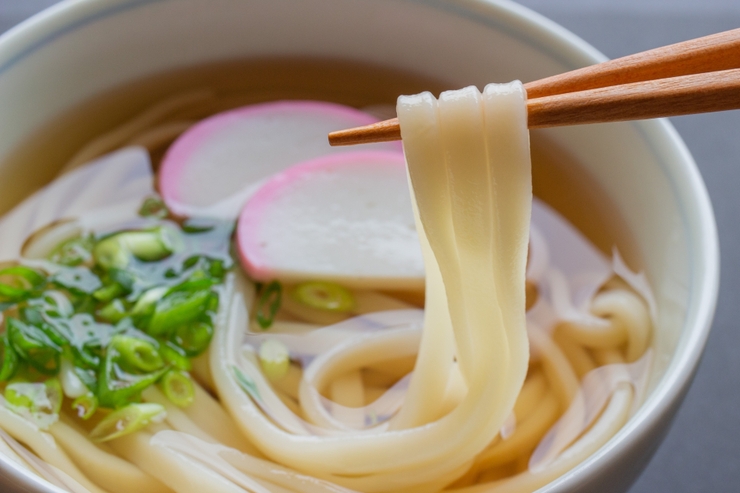
[Udon noodles]
Udon noodles refer to noodles made by adding salt water to flour. There are different types of udon noodles, such as standard udon noodles, cold and thin udon noodles called hiyamugi, flat noodles called hiramen, and fine noodles called somen. Japanese noodle-eating culture was born in the Northern Kanto and Setouchi regions, where quality wheat is produced, and has been handed down since then. It is said that in the Edo era, somen products had already been produced as local specialties in various regions ranging from Tohoku to Kyushu. Udon noodles produced in different regions, which reflect local characteristics, have different thicknesses and different elastic textures, and are eaten in different ways. There are a variety of udon noodles such as hiramen called "kishimen," noodles boiled as an ingredient of hot pot dishes, and shippoku udon made by boiling vegetables, meats, fried bean curd, and other ingredients, seasoning them with soy sauce, and pouring them over boiled noodles.
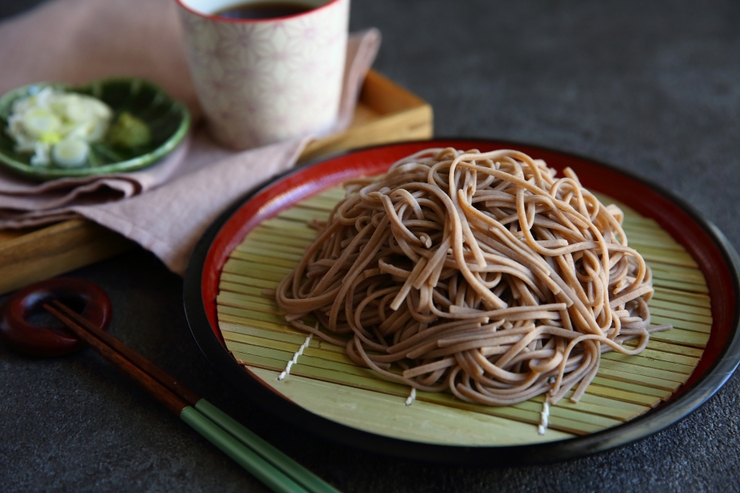
[Soba noodles]
Soba noodles are made by kneading a mixture of buckwheat flour, water, and binding agents, such as flour and eggs, and molding it into noodles. The kneaded mixture before molding into noodles is called "sobagaki." The color of soba noodles comes from the color of buckwheat berries used as an ingredient. Soba noodles are roughly divided into two types: one is sarashina soba, which is light-colored and has a light flavor, and another is yabu soba, which is dark-colored and has a strong flavor.
With improvements in flour milling technologies, soba noodle-eating culture has spread around the country. Soba noodle products are available in various forms including fresh noodles, boiled noodles, frozen noodles, dried noodles, and instant noodles.
[Rice cakes]
Rice cake culture has developed in various regions of Japan. Round rice cakes are popular around the Kansai region, while square rice cakes are popular in Kanto and regions to the north of it. Thus, there is a clear difference in rice cake shape between regions. Rice cakes are eaten in different ways in different regions. For example, rice cases are available in different forms such as cut pieces (kiri-mochi), fattened shapes (noshi-mochi), flat semicylinders (namako-mochi), diamond shapes (hishi-mochi), freeze-dried rice cake (kori-mochi), cubic rice crackers (arare-mochi), mashed rice pressed on skewers and roasted (kiritanpo), and millet dumplings (kibi dango). Rice cakes are also eaten at traditional events, and are closely related to our lives.
[Fu]
Fu is made from gluten, a protein contained in flour. It is said that the original form of fu was introduced from Tang in the Heian era. It is also said that fu came to be used in cooking in the Muromachi era, and was used in vegetarian dishes in temples or kaiseki ryori (tea ceremony dishes). Fu products became available in the Edo era, and developed into roasted gluten cakes called "yaki-fu."
Today, fu is used widely as an ingredient in Japanese cooking. In addition to yaki-fu, fresh gluten cakes called "nama-fu" and gluten cakes fried in oil called "aburaage-fu" are produced.
Production Methods
Some methods for producing three types of cereal products are introduced here.
[Udon noodles]
Udon noodles are made by adding salt water to flour and kneading the mixture. There are various standards for udon noodles, which specify ratios between flour and water, shapes into which the mixture is kneaded, ways in which the mixture is kneaded, and diameters, thicknesses, and widths of molded udon noodles. Udon noodle products are available in different forms, such as fresh noodles including fresh udon noodles, boiled udon noodles, and frozen udon noodles, and dried noodles including dried udon noodles and hand-stretched udon noodles.
Types and production methods of udon noodles and Japan Agricultural Standards (JAS)
| Classification | Name | Production method | JAS |
|---|---|---|---|
| Fresh noodles | Fresh udon noodles | Made by adding salt water to flour, kneading and flattening the mixture, and cutting it into fine strips | |
| Boiled udon noodles | Made by boiling fresh udon noodles | ||
| Frozen udon doodles | Made by freezing fresh or boiled udon noodles | ||
| Dried noodles | Dried udon doodles | Made by drying fresh udon noodles | Diameter: 1.7 mm or more |
| Dried hiyamugi | Made by drying fresh hiyamugi | Diameter: 1.3 mm or more but less than 1.7 mm | |
| Hiramen | Made by drying fresh hiramen | Width: 4.5 mm or more, thickness: less than 2.0 mm, tape shape | |
| Somen | Made by drying fresh somen | Diameter: less than 1.3 mm | |
| Hand-stretched udon noodles |
Made by applying oil on a tape-shaped noodle, stretching it into udon while twisting it, and drying it | Diameter: 1.7 mm or more, cylindrical shape or tape shape | |
| Hand-stretched hiyamugi |
Made by applying oil on a tape-shaped noodle, stretching it into hiyamugi while twisting it, and drying it | Diameter: less than 1.7 mm | |
| Hand-stretched hiramen |
Made by applying oil on a tape-shaped noodle, stretching it into hiramen, and drying it | Width: 4.5 mm or more, thickness: less than 2.0 mm, tape shape | |
| Hand-stretched somen |
Made by applying oil on a tape-shaped noodle, stretching it into somen while twisting it, and drying it | Diameter: less than 1.7 mm, cylindrical shape |
"Nihon no Dento Shokuhin Jiten" [Encyclopedia of Traditional Japanese Food] Asakura Publishing Co., Ltd., p.27
[Soba noodles]
Soba noodles are made by kneading a mixture of buckwheat flour, water, and binding agents, such as flour and eggs, and molding it into noodles. Soba noodles made by using binding agents and buckwheat flour at a ratio of 2 to 8 may be called "nihachi-soba," and soba noodles made by using no binding agents may be called "juwari-soba." There are also soba noodles made by mixing buckwheat flour with various other ingredients, such as soba noodles containing tea (cha-soba) and soba noodles containing yuzu rind (yuzukiri).
[Rice cake]
Rice cake is made by polishing glutinous rice, washing it with water, soaking it in water, draining, steaming, and pounding it, and then cooling and solidifying it. Rice cake is a traditional food made by this simple production process, but the quality of finished products largely depends on the glutinous rice used as the ingredient and the individual steps of the process.
[Fu]
First, dough is made by adding water to flour and kneading the mixture. Then, a large amount of water is added to the dough, and the mixture is further kneaded to separate gluten. Flour is added to the separated gluten, and the mixture is roasted. Yaki-fu is made by this process. Nama-fu is made by adding rice cake flour to the separated gluten and boiling or steaming the mixture. Aburaage-fu is made by frying and swelling nama-fu.
There are various production methods and product types depending on the process of separating gluten and the methods of kneading and molding the mixture.
Classification and types of fu
| Classification | Ingredients | Heat processing method | Types |
|---|---|---|---|
| Yaki-fu | Gluten, mixed flour, baking powder | Wrap dough around an iron rod and roast it over a fire | Kuruma-fu, ita-fu |
| Mold dough into a desired shape and steam and roast it in an electric kiln | Shiratama-fu, komachi-fu, chikuwa-fu, kanze-fu | ||
| Pour dough in a mold and steam and roast it in an electric kiln | Hana-fu, matsutake-fu, choji-fu | ||
| Nama-fu | Gluten, rice cake flour, mugwort, foxtail millet, etc. | Pour dough in a wooden mold and boil or steam it | Yomogi-fu, awa-fu, saiku-fu |
| Gluten, rice cake flour, red bean paste | Wrap red bean paste in dough and steam it | Fu-manju, sasamaki-fu | |
| Aburaage-fu | Gluten, mixed flour (flour or rice cake flour) | Mold dough into a desired shape and fry it in oil | Aburaage-fu |
"Nihon no Dento Shokuhin Jiten" [Encyclopedia of Traditional Japanese Food] Asakura Publishing Co., Ltd., p.40
Relationship with Regions
Of the four types of cereal products introduced before, products with features unique to a region and products that are made by a characteristic method or have a characteristic history are introduced here.
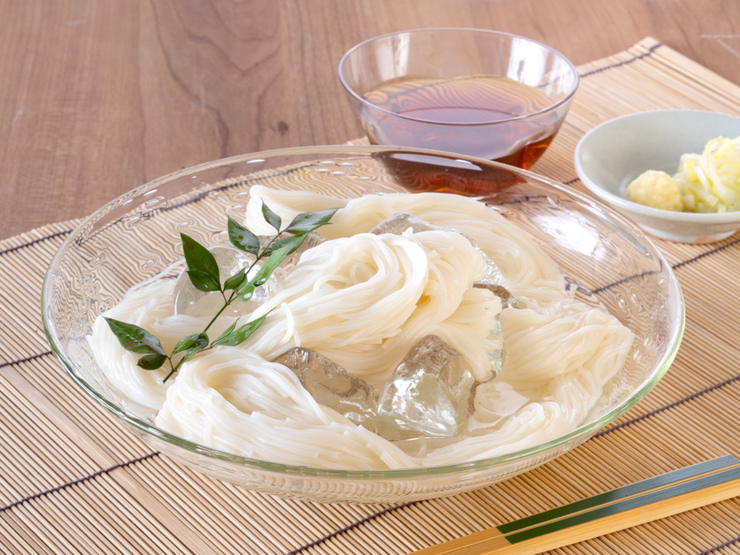
[Udon noodles]
Tape-shaped thin and wide hiramen is called "kishimen." Kishimen is a local specialty of Nagoya.
On the other hand, Kagawa Prefecture is famous as a producer of udon noodles. In Shodo-shima Island of Kagawa Prefecture, where flour and salt are produced, hand-stretched "somen" has been rooted and is eaten as a summer specialty.
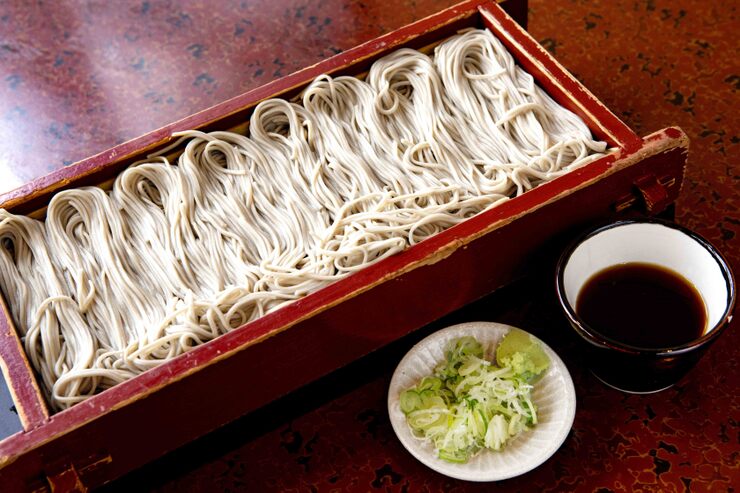
[Soba noodles]
Soba noodles that are popular as local specialties include "hegi-soba" of Niigata Prefecture, which uses "funori," a kind of seaweed, as the binding agent, and "Tsugaru-soba," which uses soybeans as the binding agent. In addition, characteristic soba noodles named after the areas of production, such as Kushiro (Hokkaido Prefecture), Tsugaru (Aomori Prefecture), Jindai-ji (Tokyo Metropolis), Togakushi and Shinshu (Nagano Prefecture), and Izumo (Shimane Prefecture), have been handed down.
Some soba noodles are attracting attention for the unique eating methods. Famous soba noodles of this kind include "wanko-soba" of Iwate Prefecture, a style where a waitperson serves hot soba noodles dipped in soup in bowls and a customer eat them one after another, "warigo-soba" of Shimane Prefecture, soba noodles served in round lacquerware and eaten with spice called "yakumi" and soba sauce, and "kawara-soba" of Yamaguchi Prefecture, cha-soba served in a heated tile together with thinly shredded egg omelet, cooked beef, lemon cut into round slices, and daikon and chili grated together.
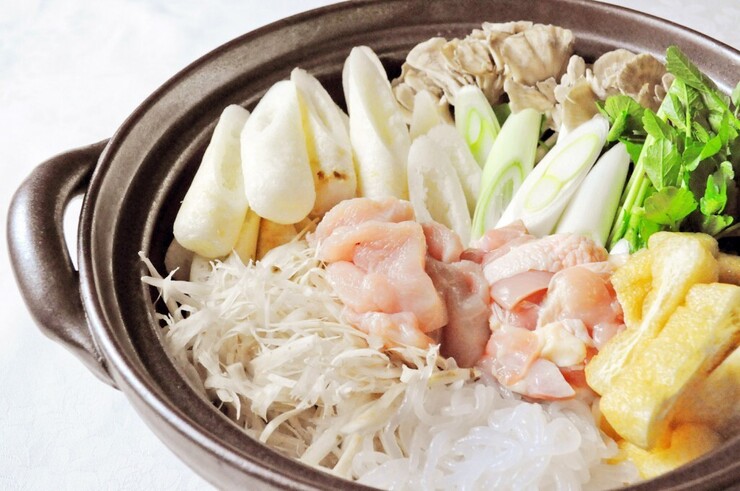
[Rice cakes]
"Noshi-mochi" is popular in Fukushima. It is rice cake flattened into a round shape, placed on a tray, and brought as a gift when making the first visit of the New Year. In the area around Nagano Prefecture, on the other hand, "kori-mochi" has been handed down. It is made by taking advantage of differences in temperature between morning and nighttime in the coldest period of winter. "kiritanpo" of Akita Prefecture is a local food made by mashing non-glutinous rice, pressing it around skewers into bars, and roasting them over charcoal. It is an indispensable ingredient for "kiritanpo nabe," a traditional hot pot dish of Akita Prefecture.
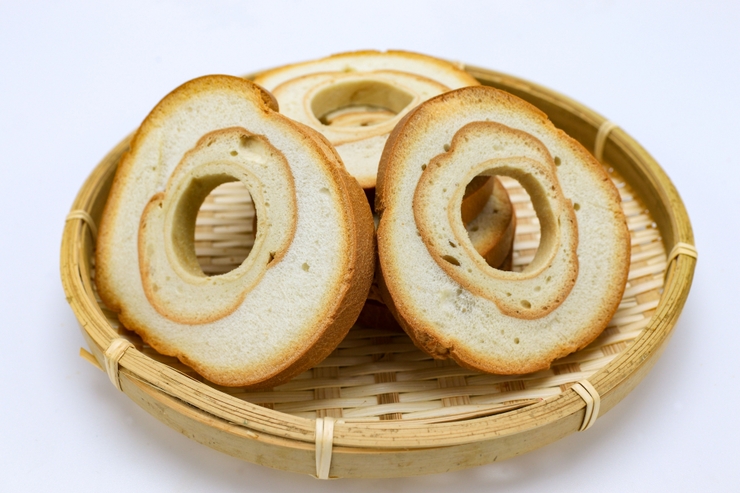
[Fu]
There are different production methods and shapes of yaki-fu depending on the area of production. "kuruma-fu" is a local specialty of Yamagata Prefecture, Niigata Prefecture, Toyama Prefectures, Ishikawa Prefecture, and some other regions, and "shonai-fu (ita-fu)" is a local specialty of the Shonai region in Yamagata Prefecture. Fu that has been roasted and bubbled evenly is considered of good quality. Yaki-fu does not easily lose its shape.
Nama-fu lasts shorter than yaki-fu at room temperature. Its production volume is limited, and nama-fu with different characteristics are produced in different regions. Famous nama-fu products include "kyo-nama-fu" of Kyoto Prefecture, which is made by mixing foxtail millet, buckwheat, mugwort, etc. as ingredients, "kaga-fu" of Ishikawa Prefecture, which is used commonly as a foodstuff in vegetarian dishes and is also used as an ingredient for "jibuni," a local dish, and "tsushima-fu" of Aichi Prefecture, which is made by boiling gluten and immersing it in cold water. "Abura-fu," which is said to have originated from vegetarian dishes, is a local specialty of Miyagi Prefecture.
Contribution to Sustainability and SDGs
Recently, rice flour has been attracting attention. It has a good amino acid balance, is highly nutritious, is easy to cook, and has a low oil absorption rate, and recently, rice flour designed to suit cooking methods has been developed. Increases in consumption of rice flour made in Japan are expected to increase Japan's food self-sufficiency rate. (13. Climate Action)
Reference
Masaharu Horii, Koichi Nakamura, Hirokazu Yoshii, Katsuya Nakagawa, Masatoshi Manabe, Toru Imai, Seichi Nagao, and Tsuyoshi Takiguchi, edited by the Japanese Society of Traditional Food, "Nihon no Dento Shokuhin Jiten" [Encyclopedia of Traditional Japanese Food] Asakura Publishing Co., Ltd., p.3-43

